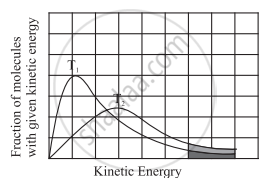Advertisements
Advertisements
Question
Answer the following in brief.
Explain graphically the effect of temperature on the rate of reaction.
Solution
i. The average kinetic energy of molecules is proportional to temperature.
ii. At a given temperature, the fraction of molecules with their kinetic energy equal to or greater than Ea may lead to the product.
iii. With an increase in temperature, the fraction of molecules having their energies (Ea) would increases. The rate of the reaction thus would increase.
iv. This is depicted by plotting a fraction of molecules with given kinetic energy versus kinetic energy for two different temperatures T1 and T2 (T2 > T1). The area between the curve and the horizontal axis is proportional to the total number of molecules. The total area is the same at T1 and T2.

Comparison of fraction of molecules activated at T1 and T2
v. The entire shaded area which represents a fraction of molecules with kinetic energy exceeding Ea is larger at T2 than at T1 (since T2 > T1).
vi. This indicates that a fraction of molecules possessing energies larger than Ea increase with temperature. The rate of reaction increases accordingly.
RELATED QUESTIONS
Answer the following in one or two sentences.
Write the Arrhenius equation and explain the terms involved in it.
Solve
What is the energy of activation of a reaction whose rate constant doubles when the temperature changes from 303 K to 313 K?
The rate constant of a reaction at 500°C is 1.6 × 103 M−1 s−1. What is the frequency factor of the reaction if its activation energy is 56 kJ/mol?
The rate constant for the first-order reaction is given by log10 k = 14.34 – 1.25 × 104 T. Calculate activation energy of the reaction.
Answer the following in brief.
How will you determine activation energy from rate constants at two different temperatures?
Explain with the help of the Arrhenius equation, how do the rate of reaction changes with activation energy.
Which among the following is correct when energy of activation, Ea of the catalyzed reaction decreases at constant temperature and for same concentration?
A catalyst lowers the activation energy of a certain reaction from 83.314 to 75 kJ mol−1 at 500 K. What will be the rate of reaction as compared to uncatalysed reaction? Assume other things are equal.
Which among the following equation represents Arrhenius equation?
Slope of the straight line obtained by plotting log10k against represents what term?
Explain with the help of Arrhenius equation, how does the rate of reaction changes with temperature.
Explain with the help of Arrhenius equation, how does the rate of reaction changes with activation energy.
Explain with the help of Arrhenius equation, how does the rate of reaction changes with temperature.
Explain with the help of Arrhenius equation, how does the rate of reaction changes with activation energy.
Explain, with the help of the Arrhenius equation, how does the rate of reaction changes with activation energy.
Explain with the help of the Arrhenius equation, how do the rate of reaction changes with activation energy.
Explain with the help of Arrhenius equation, how does the rate of reaction changes with temperature.
Explain with the help of Arrhenius equation, how does the rate of reaction changes with temperature.
Explain with the help of Arrhenius equation, how does the rate of reaction changes with activation energy.
Explain with the help of Arrhenius equation, how does the rate of reaction changes with activation energy.
Explain with the help of Arrhenius equation, how does the rate of reaction changes with temperature.
Explain with the help of Arrhenius equation, how does the rate of reaction changes with temperature.
